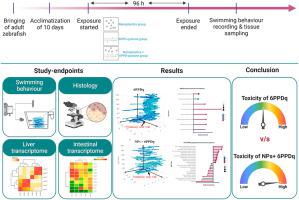当前位置:
X-MOL 学术
›
Environ. Pollut.
›
论文详情
Our official English website, www.x-mol.net, welcomes your feedback! (Note: you will need to create a separate account there.)
Mixture toxicity of 6PPD-quinone and polystyrene nanoplastics in zebrafish
Environmental Pollution ( IF 8.9 ) Pub Date : 2024-03-21 , DOI: 10.1016/j.envpol.2024.123835 Shubham Varshney , Olivia L. O'Connor , Adnan Hussain Gora , Saima Rehman , Viswanath Kiron , Prabhugouda Siriyappagouder , Dalia Dahle , Tanja Kögel , Robin Ørnsrud , Pål A. Olsvik
Environmental Pollution ( IF 8.9 ) Pub Date : 2024-03-21 , DOI: 10.1016/j.envpol.2024.123835 Shubham Varshney , Olivia L. O'Connor , Adnan Hussain Gora , Saima Rehman , Viswanath Kiron , Prabhugouda Siriyappagouder , Dalia Dahle , Tanja Kögel , Robin Ørnsrud , Pål A. Olsvik

|
Plastic pollution, including micro- and nanoplastics, is a growing concern. Tyre-wear particles (TWPs) are the second largest source of microplastics in the ocean following abrasion of synthetic fibres. In addition to the particles themselves, TWPs contain many harmful chemicals, including 6PPD. This chemical reacts with atmospheric ozone and forms the toxic compound 6PPD-quinone (6PPDq), which poses a danger to aquatic life. There is a knowledge gap in understanding risks associated with the combined toxicity of nanoplastics (NPs) and 6PPDq. The present study aimed to investigate the toxicity of NPs and 6PPDq on adult zebrafish using phenotypic (behaviour, histology) and transcriptomic endpoints. Zebrafish were exposed to four treatments: control (contaminant-free), 50 μg/L 6PPDq, 3 mg/L polystyrene (PS)-NPs, and a combination of 50 μg/L 6PPDq and 3 mg/L PS-NPs. We did not observe locomotory dysregulation in zebrafish exposed to NPs. However, we found significant hyperlocomotion in zebrafish exposed to 6PPDq and this effect was even more substantial after co-exposure with PS-NPs. This study explores the molecular mechanisms behind these effects, identifying genes associated with neurotransmitters and fatty acid metabolism that were dysregulated by the co-exposure. Transcriptomic analysis further showed that both 6PPDq and PS-NPs impacted cellular processes associated with sterol biosynthesis, cholesterol metabolism, and muscle tissue development. The effects on these mechanisms were stronger in co-exposed zebrafish, indicating a heightened risk to cellular integrity and mitochondrial dysfunction. These results highlight the significance of mixture toxicity when studying the effects of NPs and associated chemicals like 6PPDq.
中文翻译:

6PPD-醌和聚苯乙烯纳米塑料的混合物对斑马鱼的毒性
塑料污染,包括微米塑料和纳米塑料,日益引起人们的关注。轮胎磨损颗粒(TWP)是海洋中仅次于合成纤维磨损的第二大微塑料来源。除了颗粒本身之外,TWP 还含有许多有害化学物质,包括 6PPD。这种化学物质与大气臭氧发生反应,形成有毒化合物 6PPD-醌 (6PPDq),对水生生物构成危险。在了解与纳米塑料 (NP) 和 6PPDq 的组合毒性相关的风险方面存在知识差距。本研究旨在利用表型(行为、组织学)和转录组终点研究 NP 和 6PPDq 对成年斑马鱼的毒性。斑马鱼接受四种处理:对照(无污染物)、50 μg/L 6PPDq、3 mg/L 聚苯乙烯 (PS)-NP 以及 50 μg/L 6PPDq 和 3 mg/L PS-NP 的组合。我们没有观察到接触纳米颗粒的斑马鱼出现运动失调。然而,我们发现暴露于 6PPDq 的斑马鱼出现显着的过度运动,并且在与 PS-NP 共同暴露后这种效果甚至更加显着。这项研究探讨了这些影响背后的分子机制,识别了与神经递质和脂肪酸代谢相关的基因,这些基因因共同暴露而失调。转录组分析进一步表明,6PPDq 和 PS-NP 都会影响与甾醇生物合成、胆固醇代谢和肌肉组织发育相关的细胞过程。在共同暴露的斑马鱼中,对这些机制的影响更强,表明细胞完整性和线粒体功能障碍的风险更高。这些结果凸显了在研究 NP 和 6PPDq 等相关化学品的影响时混合物毒性的重要性。
更新日期:2024-03-21
中文翻译:

6PPD-醌和聚苯乙烯纳米塑料的混合物对斑马鱼的毒性
塑料污染,包括微米塑料和纳米塑料,日益引起人们的关注。轮胎磨损颗粒(TWP)是海洋中仅次于合成纤维磨损的第二大微塑料来源。除了颗粒本身之外,TWP 还含有许多有害化学物质,包括 6PPD。这种化学物质与大气臭氧发生反应,形成有毒化合物 6PPD-醌 (6PPDq),对水生生物构成危险。在了解与纳米塑料 (NP) 和 6PPDq 的组合毒性相关的风险方面存在知识差距。本研究旨在利用表型(行为、组织学)和转录组终点研究 NP 和 6PPDq 对成年斑马鱼的毒性。斑马鱼接受四种处理:对照(无污染物)、50 μg/L 6PPDq、3 mg/L 聚苯乙烯 (PS)-NP 以及 50 μg/L 6PPDq 和 3 mg/L PS-NP 的组合。我们没有观察到接触纳米颗粒的斑马鱼出现运动失调。然而,我们发现暴露于 6PPDq 的斑马鱼出现显着的过度运动,并且在与 PS-NP 共同暴露后这种效果甚至更加显着。这项研究探讨了这些影响背后的分子机制,识别了与神经递质和脂肪酸代谢相关的基因,这些基因因共同暴露而失调。转录组分析进一步表明,6PPDq 和 PS-NP 都会影响与甾醇生物合成、胆固醇代谢和肌肉组织发育相关的细胞过程。在共同暴露的斑马鱼中,对这些机制的影响更强,表明细胞完整性和线粒体功能障碍的风险更高。这些结果凸显了在研究 NP 和 6PPDq 等相关化学品的影响时混合物毒性的重要性。



























 京公网安备 11010802027423号
京公网安备 11010802027423号